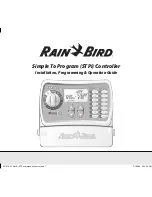
9
Under the
DPV1 Data Records
, configure the following:
a
In the
Data Type (DPV1DATATYPE)
list, select the data type as required from the list of supported
data types for each
Parameter Name (DPV1PARAMNAME)
.
Attention
The Octet string data type is not supported.
b
In the
Value (DPV1PARAMVALUE)
box, type the parameter value for writing or monitoring the DPV1
parameter value.
c
In the
Parameter Name (DPV1PARAMNAME)
box, type the parameter name.
d
In the
Byte Offset (DPV1BYTEOFFSET)
box, type the byte offset value of the parameter, which needs
to be mapped from the DPV1 response.
e
In the
Bit Offset (DPV1BITOFFSET)
box, type the bit offset value of the parameter, which needs to
mapped from the DPV1 response.
Attention
This parameter is available for configuration only when the data type is configured as “Boolean.”
10
Click
OK
.
7.2.2 HART communication/response time impact in a DP network
The following factors can impact the DPV1/ HOP scan time in a DP network.
HART devices that are distributed per slave
If there are more number of HART devices configured in a single slave, then PGM takes more time to complete
HOP scan than the slaves that contains less number of HART devices. This is because the DPV1 command for
each HART device needs to be sent only after the previous command response is received.
DP Network baud rate
DP Network baud rate has direct impact on any communication on the DP network. If the baud rate is high, then
the time taken to receive the response is less. Similarly, if the baud rate is less, then the time taken to receive the
response is more. In addition, if the baud rate is high, then more commands can be sent in allocated DPV1
bandwidth. If baud rate is low, then less number of command in the allocated DPV1 bandwidth.
Allocated DPV1 Bandwidth
The DPV1 requests are sent in a single cycle based on the configured DPV1 BANDWIDTH parameter value,
and hence DPV1BANDWIDTH value has direct impact on the scan time of DPV1 requests.
Slaves capability
Some of the slaves has the capability to serve more than one DPV1 request at a time and some of the slaves
supports only one request at a time.
Field Device Manager (FDM) requests
If the FDM is connected to the DP network and communicates to the devices that are configured, then the FDM
takes priority than the HOP and DPV1 requests. Therefore, the FDM requests also has a direct impact on the
HART communication.
Configured DPV1 Requests
The number of DPV1 requests that are configured for each slave and the priorities also have an impact on the
HART command response time-out since both the DPV1 and HOP requests are serviced.
7 DEVICE SUPPORT BLOCK (DSB)
116
www.honeywell.com
Summary of Contents for Experion PKS
Page 1: ...Experion PKS PROFIBUS Gateway Module User s Guide EPDOC XX88 en 431E June 2018 Release 431 ...
Page 8: ...CONTENTS 8 www honeywell com ...
Page 10: ...1 ABOUT THIS GUIDE 10 www honeywell com ...
Page 32: ...4 PROFIBUS GATEWAY MODULE PGM INSTALLATION 32 www honeywell com ...
Page 58: ...5 PROFIBUS GATEWAY MODULE PGM BLOCK 58 www honeywell com ...
Page 69: ...6 PROTOCOL BLOCK 69 ...
Page 103: ...5 Click OK 6 PROTOCOL BLOCK 103 ...
Page 110: ...6 PROTOCOL BLOCK 110 www honeywell com ...
Page 183: ...PDC Details tab Figure 6 Detail Display of PDC Details tab 7 DEVICE SUPPORT BLOCK DSB 183 ...
Page 186: ...7 DEVICE SUPPORT BLOCK DSB 186 www honeywell com ...
Page 231: ...9 PROFIBUS I O MODULE PIOMB FUNCTION BLOCK 231 ...
Page 232: ...9 PROFIBUS I O MODULE PIOMB FUNCTION BLOCK 232 www honeywell com ...
Page 236: ...10 PROFIBUS GATEWAY MODULE PGM CONFIGURATION EXAMPLE 236 www honeywell com ...
Page 264: ...13 PROFIBUS GATEWAY MODULE PGM TROUBLESHOOTING 264 www honeywell com ...
















































